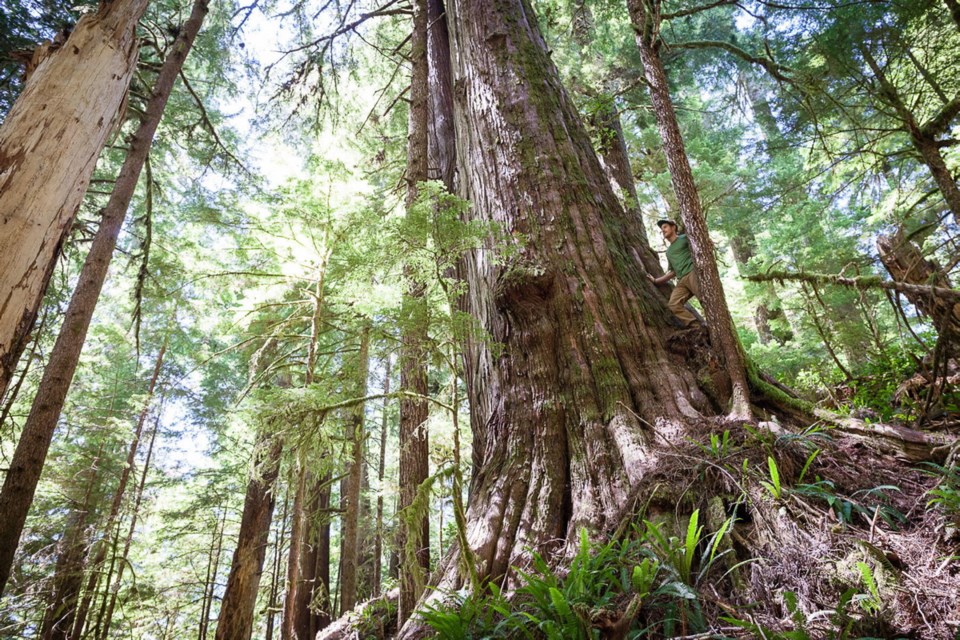At the end of a logging road, past expanses of clear-cut land, is the entrance to one of the largest contiguous tracts of old-growth rainforest on Vancouver Island.
The Central Walbran Valley near Port Renfrew is not protected parkland, but has incalculable ecological value, environmentalists say.
“You come to this area of pristine old growth and everything changes. Your mood changes. It’s — how do I put it — it gives you a feeling of well-being,” said environmentalist Saul Arbess.
“An undisturbed ancient forest like that is extraordinary.”
Arbess is one of many environmentalists mobilizing to protect a portion of the valley around Castle Grove known as “The Bite” for its bite-shaped exclusion from neighbouring Carmanah Walbran Provincial Park. The ancient western red cedars, sitka spruce and hemlock forests are home to species such as the threatened marbled murrelet.
Tonight at 7 p.m., environmentalists plan to gather at the Fernwood Community Centre to discuss next steps in their campaign to stop Surrey-based Teal-Jones Group from carrying out plans to log eight cutblocks in the 486-hectare area.
It’s a familiar battle for Arbess, with a familiar foe in the forestry industry. In the early 1990s, Arbess took part in a lengthy blockade of logging trucks in the Walbran Valley, as part of an ongoing “war in the woods” that included the massive Clayoquot Sound protests in 1993.
The conflict ended with Teal Jones surrendering 7,035 hectares of its licence to form Carmanah Walbran Provincial Park. But multiple flare-ups since then suggest negotiators didn’t quite get it right.
“We live with the mistakes of history, there’s no question about it,” Arbess said.
For representatives from Teal Jones, which employs more than 1,000 people, enough compromises have been made already.
Chief financial officer Hanif Karmally said the company has 59,884 hectares within its tree-farm licence, but almost 30 per cent is protected from harvest because of ecological considerations such as wildlife habitats or riparian areas.
Seventy-four per cent of the remaining timber-harvest land base is immature, leaving 11,080 hectares available to harvest.
“When the Carmanah-Walbran park was created, there was a conscious decision to allow old-growth logging outside of the park boundaries and Teal wishes to pursue this,” Karmally said.
“Further reductions would be extremely detrimental to Teal’s logging and sawmilling operations.”
Teal Jones had applied to begin logging one of its eight cutblocks on July 13, but all harvesting is on hold for the fire season, Karmally said.
A spokesman for the Ministry of Forests, Lands and Natural Resource Operations said the province is evaluating Teal Jones’s application.
But Teal Jones is within its legal rights to log the area, another spokesman said, with a province-approved forest-stewardship plan in place.
Torrance Coste, Vancouver Island campaigner for the Wilderness Committee environmental group, said second-growth forests can’t be considered adequate replacements for old-growth ones.
“If a tree is 1,200 or 1,400 years old, then the ecosystem around it has developed for that long, too. You can’t just replicate that when you log and replant,” he said.
Old-growth forests also serve as an important carbon sink for mitigating the effects of climate change, Coste said.
Peter Cressey, a member of Friends of Carmanah/Walbran, said he believes the best strategy for protecting the forest is bringing people to see it. Although he participated in blockades during the war in the woods, he doesn’t believe that will be necessary this time.
“Back in the ’90s, it was a small group of people labelled as treehuggers. Now it’s become more mainstream,” he said.
The Friends are creating a “witness trail” for people to take a 1.5-hour hike into the woods.
“We like the idea that you have to witness something before making a decision.”



